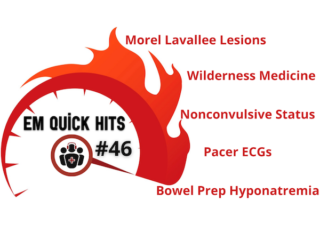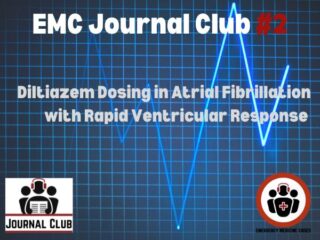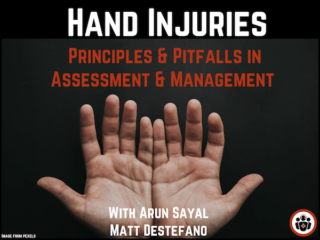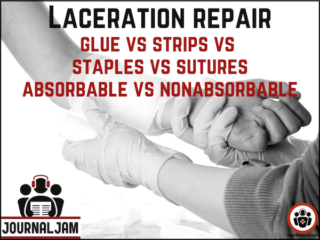Most Recent
EM Quick Hits 46 – Wilderness Medicine, Bowel Prep Hyponatremia, Non-Convulsive Status Epilepticus, Morel Lavallee Lesions, Pacemaker ECGs, Loans vs Investing
In this EM Quick Hits podcast: Justin Hensley and Aaron Billin on Wilderness Medicine, Elisha Targonsky on Bowel Prep Hyponatremia, Brit Long on Non-Convulsive Status Epilepticus, Andrew Petrosoniak on Morel Lavallee Lesions, Jesse McLaren on Pacemaker ECGs and Matt Poyner on paying off loans vs investing... https://stg-emergencymedicinecases-emcstaging.kinsta.cloud/donation/
JJ 23 Laceration Aftercare – Dressings, Antibiotics, Improving Cosmesis, Preventing Infection
In this Part 3 of our 3-part podcast series on management of lacerations Dr. Haley Cochrane joins Anton and Justin to explore laceration aftercare and the evidence for keeping wounds dry or wet, wound dressings, topical antibiotics, prophylactic oral antibiotics, Vitamin E oil, aloe vera cream and UV protection with regards to cosmetic outcomes and infection rates. What may be the most important aspect of aftercare is educating the patient what to expect as the laceration heals and when they should seek medical attention...
Journal Club 2 – Diltiazem Dosing in Atrial Fibrillation with Rapid Ventricular Response
Is low dose diltiazem as effective and safer than standard dose diltiazem for rate control in patients with atrial fibrillation with rapid ventricular response? Dr. Rohit Mohindra and Dr. Shelley McLeod critically appraise the latest study on diltiazem dosing and deliver a research methodology hot take on this month's EM Cases Journal Club...
EM Cases Summit Video Streaming Package Now Available
If you missed The EM Cases Summit '23, no worries, we've got you covered! All the main stage talks of both the 2023 and 2021 Summits are now available for video streaming, on your own time, for a limited time only thru emcasessummit.com. Plus you get the 2023 and 2021 eBooks summarizing the talks as a bonus. New EM Cases swag too...
Ep 178 Hand Injuries – Pitfalls in Assessment and Management
The hand is anatomically complex. Having an anatomical-based approach to the assessment of patients who present to the Emergency Department is important to preserve quality of life following a hand injury. Hand injuries are the second most common injury leading to days without work. It is no surprise then that open finger injuries land in the top 10 most common diagnoses that end up in court. In this first part of our two-part series on hand injuries Dr. Matt Distefano and Dr. Arun Sayal guide us through the principles and pitfalls of assessment and management of hand injuries and answer questions such as: what is the differential diagnosis of a globally swollen hand? What is the intrinsic minus hand position? When should we suspect compartment syndrome of the hand? How should we best locate retracted lacerated tendons of the hand? What are the best ways to control bleeding of a finger tip amputation? What are the best analgesic choices? How large of a skin avulsion hand injury should we let heal by secondary intention rather than recommend a flap/skin graft? and many more...
JJ 22 Laceration Repair – Glue vs Strips vs Staples vs Sutures
In this Part 2 of our 3-part Journal Jam series on Laceration Management we dive into the evidence for the choice of material to close lacerations. Which is best for which kind of laceration? Surgical skin glue? Wound adhesive strips? Surgical staples? Absorbable sutures? Nonabsorbable sutures?...







